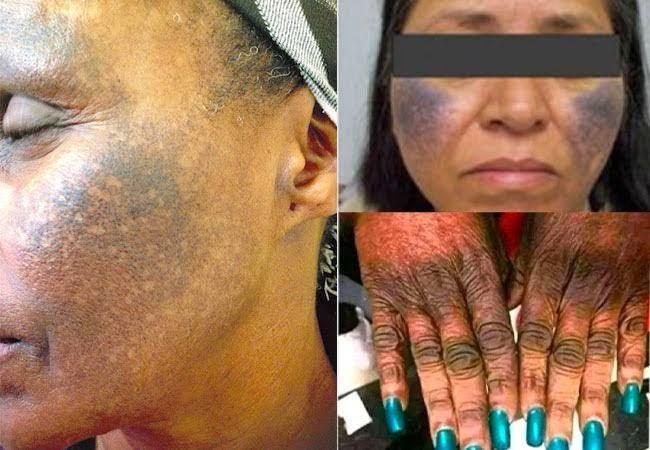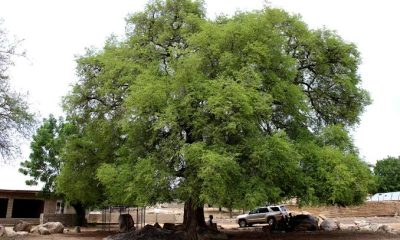News
LIGHTNING CREAMS’ DETRIMENTAL IMPACT ON HEALTH

LIGHTNING CREAMS’ DETRIMENTAL IMPACT ON HEALTH
By: Omirin Joshua
Previously, skin bleaching and toning was considered a fashionable attribute of the wealthy, particularly among those who had lived abroad for an extended period of time. With the passage of time, the fashion trend became a fad for individuals of various and varying socioeconomic statuses, and local and foreign corporations began to compete to manufacture various skin care products and soaps with appealing fragrances and colours in order to keep the fad alive.
While this practice may seem harmless, it can actually have serious consequences for one’s health. In addition to these treatments, some people self-mix a range of substances, such as mixtures of numerous commercial skin-bleaching solutions with hydrogen peroxide, to create their own homemade products.
Some people bleach or whiten their skin for a variety of reasons, including desiring to have a beautiful and enticing face and removing unsightly body markings, among others, which some experts believe may be psychological. Some parents who have succumbed to the psychological pull have even extended the preoccupation to their children, including toddlers.
Not only are the chemicals in these creams harmful to the skin, but they can also cause long-term damage to the liver, kidneys, and other organs. In addition, the use of skin lightening creams can have a negative impact on self-esteem and body image.
The hazards linked with skin-bleaching cremes and creams are genuine and worrisome, since powerful chemicals wreak havoc on the user’s skin. In this article, we break through the hype to get to the bottom of the issue, exposing the indisputable health hazards and horrifying side effects of skin-lightening cremes and showing methods to live a better and happier life.
The National Agency for Food and Drug Administration and Control (NAFDAC) has said that a study done by the World Health Organization (WHO) revealed that 77 percent of Nigerian women use skin bleaching creams, the highest in Africa, compared to 59 percent in Togo, 35 percent in South Africa, and 27 percent in Senegal.
The active ingredients in skin lightening creams can cause a variety of physical side effects, including, Skin irritation, dryness, and redness, Scarring, hyperpigmentation, Premature aging of the skin and skin cancer. These side effects are caused by the chemicals used in skin lightening creams, such as hydroquinone, mercury, and steroids. These chemicals can cause damage to the skin cells and lead to serious health problems. Hydroquinone, one of the main ingredients in skin lightening creams, can cause dryness, itching, and redness of the skin. If used over a long period of time, it can lead to a condition called ochronosis, in which the skin becomes thick, hard, and leathery. Another common ingredient, steroids, can cause thinning of the skin and an increased risk of infection. Mercury, another common ingredient, can cause a condition called mercury poisoning.
Mercury poisoning can cause a number of serious health problems, including damage to the kidneys, liver, and nervous system. Other health risks associated with skin lightening creams include premature aging of the skin and an increased risk of skin cancer. These health risks are often overlooked by those who use skin lightening creams, but they are very real and should not be ignored. If you are considering using a skin lightening cream, it is important to be aware of the potential health risks involved. It is also important to consult with a dermatologist or other healthcare professional before starting any skin lightening regimen.
In conclusion, it’s critical to realize that using skin-lightening creams can have detrimental effects on one’s physical and mental health. Using these creams can result in negative body image and low self-esteem in addition to the physical side effects mentioned above. Many users of skin-lightening creams do so as a result of pressure to meet unattainable beauty standards. Cosmetics enriched with harmful chemicals have an indirect impact on nature, as the waste and residues of these products pollute the environment. The residue from these products contaminates the water as soon as the user showers or cleans their face. After using the product, there is a high probability that the residues in the product container containing harmful chemicals will end up in nature. Yet the global skin lightening market is highly unregulated and is estimated to be worth billions of dollars. However, these products can have serious health risks, and the best way to achieve a healthy and happy life is to embrace your natural skin tone. You are beautiful just the way you are!
Godiya Sardauna Molyini.
Department of Mas Communication.
University of Maiduguri.
LIGHTNING CREAMS’ DETRIMENTAL IMPACT ON HEALTH
News
U.S. president orders deadly strikes against ISIS militants in northwest Nigeria

U.S. president orders deadly strikes against ISIS militants in northwest Nigeria
By: Zagazola Makama
President Donald J. Trump announced that the United States had launched a powerful and deadly military strike against Islamic State (ISIS) terrorist targets in Nigeria, in response to what he described as ongoing attacks on primarily innocent Christians in the region.
In a post on his social media platform, Mr. Trump said the operation was conducted “at my direction as Commander in Chief” and targeted ISIS militants whom he accused of “viciously killing, primarily, innocent Christians, at levels not seen for many years, and even centuries.”
The president said he had previously warned the extremist group to halt attacks on Christians or face consequences, adding: “tonight, there was.”
Mr. Trump described the strikes as “numerous perfect strikes, as only the United States is capable of doing,” and reiterated that under his leadership the U.S. would not allow “Radical Islamic Terrorism to prosper.” He extended Christmas greetings to U.S. military forces and said there would be “many more” such strikes if the killing of Christians continued.
The announcement marks a significant escalation of U.S. military involvement in Nigeria’s complex security landscape. Western and Nigerian officials have long warned that militant groups such as ISIS’s West Africa Province (ISWAP) and Boko Haram pose a persistent threat in northern Nigeria, where attacks on civilians including Christians and Muslims alike have killed thousands over the past decade.
Reactions to the U.S. action are still emerging. The strikes come amid ongoing debates over Nigeria’s sovereignty and the best approach to combat extremist violence in West Africa. Previous statements by the Nigerian government welcomed U.S. assistance in fighting terrorism provided it respects the country’s territorial integrity.
The full military impact of the operation including casualties among militants or its implications for Nigeria’s internal security strategy has not yet been independently verified.
End
News
VP Shettima: Borno Attack Will Not Break Nigeria’s Resolve

VP Shettima: Borno Attack Will Not Break Nigeria’s Resolve
By: Our Reporter
Vice President Kashim Shettima has condemned in strong terms the bomb explosion that claimed about five lives and left several others injured at a Mosque in Gamboru Market, Maiduguri, Borno State, describing the attack as a despicable assault on innocent citizens and the peace of the nation.
The Vice President said President Bola Ahmed Tinubu has ordered an immediate intensification of security operations in Borno State following the incident.
In a statement on Thursday, the Vice President condemned the attack, assuring that the Federal Government is deploying additional tactical teams to the area to track down and apprehend those responsible for the terror attack.
“The Federal Government will not tolerate any attempt to undermine the peace and security of our nation. Our security agencies are working round the clock to ensure that the perpetrators of this heinous crime are brought to justice immediately,” he said.
Senator Shettima expressed confidence that the security architecture currently in place would not only apprehend the perpetrators but also unravel the full circumstances surrounding the incident.
“We sympathize with the Government of Borno State, residents, and families who have lost their loved ones in this attack. The Federal Government is confident that those responsible for this despicable act of terrorism will face the full weight of the law,” VP Shettima said.
He assured Nigerians that the Tinubu administration’s commitment to national security, anchored in constitutional duty, remains unwavering.
“Since President Bola Ahmed Tinubu assumed office in 2023, this administration has consistently reaffirmed its unyielding commitment to safeguarding the security, unity, and stability of our nation.
“This commitment remains steadfast under God and the Constitution of the Federal Republic of Nigeria. We will continue to provide our security agencies with all necessary resources and support to decisively defeat terrorism in all its forms,” he affirmed.
The Vice President added that the Federal Government is working closely with state authorities and local security agencies to ensure protection of vulnerable communities and critical infrastructure across the North East and other regions.
VP Shettima: Borno Attack Will Not Break Nigeria’s Resolve
News
Zulum-“Protect Our Sacred Bond,” Celebrates Peaceful Year in Christmas Message

Zulum-“Protect Our Sacred Bond,” Celebrates Peaceful Year in Christmas Message
By: Our Reporter
With profound gratitude to God for sparing our lives one full year to another Christmas celebration, Borno State Governor, Professor Babagana Umara Zulum felicitate with the Christian community across the state on the occasion of Christmas.
The Governor is currently engaged in a four-day security and resilience building tour across Northern Borno. The tour includes visits to military formations to boost their morale, and to communities affected by the insurgency, where he is working to build their confidence and provide tangible democratic benefits.
In a message by his Spokesperson Dauda Iliya, Governor Zulum expressed gratitude to God Almighty for the return of relative peace in the state.
“For us in Borno State, the period between the 2024 to the 2025 Christmas celebrations has been one full year of celebrating enviable all-encompassing reconstruction and recovery,” Zulum stated.
“The progress is not only in terms of physical infrastructure, but also in terms of the peace and forbearance, mutual goodwill and harmonious coexistence among the Muslim and Christian communities, which our beleaguered state very critically desires to launch itself back to prosperity and glorious past,” he added.
“I feel obliged to express my most heartfelt gratitude to God for enabling me to preside over the state one full year, witnessing a gladdening restoration and maintenance of these required peace, mutual goodwill and harmony between the the Muslim and Christian communities which bonded us tightly together as a solid people, but which the over a decade Boko Haram insurgency threatened to completely destroy.
“A noteworthy part of the Muslim-Christian harmonious coexistence and goodwill reconstruction and maintenance was my recent high-level consultation meeting with the leadership of Jama’atu Nasril Islam (JNI) and Christian Association of Nigeria (CAN), focused on strengthening collaborative efforts between the state government and religious bodies to combat the lingering threat of insecurity and foster lasting peace in Borno State.
“At that meeting, I underscored the critical role of religious leaders in promoting tolerance, unity and peace across the state because Borno, like many states, has unique and beautiful family composition dynamics.
“It is common to find under one roof, brothers and sisters, uncles and aunts, who profess different faiths. We share meals, we celebrate festivities and milestones, we grieve losses together, as one family, bound by blood and love that transcends religious labels. This is our reality.
“I stressed that our enviable strength emanates from this reality. I will still, therefore, stress that we must protect this sacred bond within our homes and allow it to define our individual, as well as intra- and cross-community engagements.
“In sustenance of my tradition of just, fair and equitable treatment of both communities in festive seasons, I have, also, this year, I announced support to the Christian community and non indigenes, which includes free transportation to non-indigenes to different parts of the country, humanitarian support to over 6,000 vulnerable Christians, cash gifts to widows and orphans, sponsorship of Christian pilgrimage and other interventions.
I am always disposed to rendering such support, and even more, whenever the need arises.
Governor Babagana Zulum urge every citizen of the state, irrespective of faith, to come together in the collective search for lasting security, peaceful and harmonious coexistence as the most-critical foundation for true reconstruction, recovery and prosperity.
Zulum-“Protect Our Sacred Bond,” Celebrates Peaceful Year in Christmas Message
-

 News2 years ago
News2 years agoRoger Federer’s Shock as DNA Results Reveal Myla and Charlene Are Not His Biological Children
-

 Opinions4 years ago
Opinions4 years agoTHE PLIGHT OF FARIDA
-

 News8 months ago
News8 months agoFAILED COUP IN BURKINA FASO: HOW TRAORÉ NARROWLY ESCAPED ASSASSINATION PLOT AMID FOREIGN INTERFERENCE CLAIMS
-

 Opinions4 years ago
Opinions4 years agoPOLICE CHARGE ROOMS, A MINTING PRESS
-

 News2 years ago
News2 years agoEYN: Rev. Billi, Distortion of History, and The Living Tamarind Tree
-

 ACADEMICS2 years ago
ACADEMICS2 years agoA History of Biu” (2015) and The Lingering Bura-Pabir Question (1)
-

 Columns2 years ago
Columns2 years agoArmy University Biu: There is certain interest, but certainly not from Borno.
-

 Opinions2 years ago
Opinions2 years agoTinubu,Shettima: The epidemic of economic, insecurity in Nigeria





